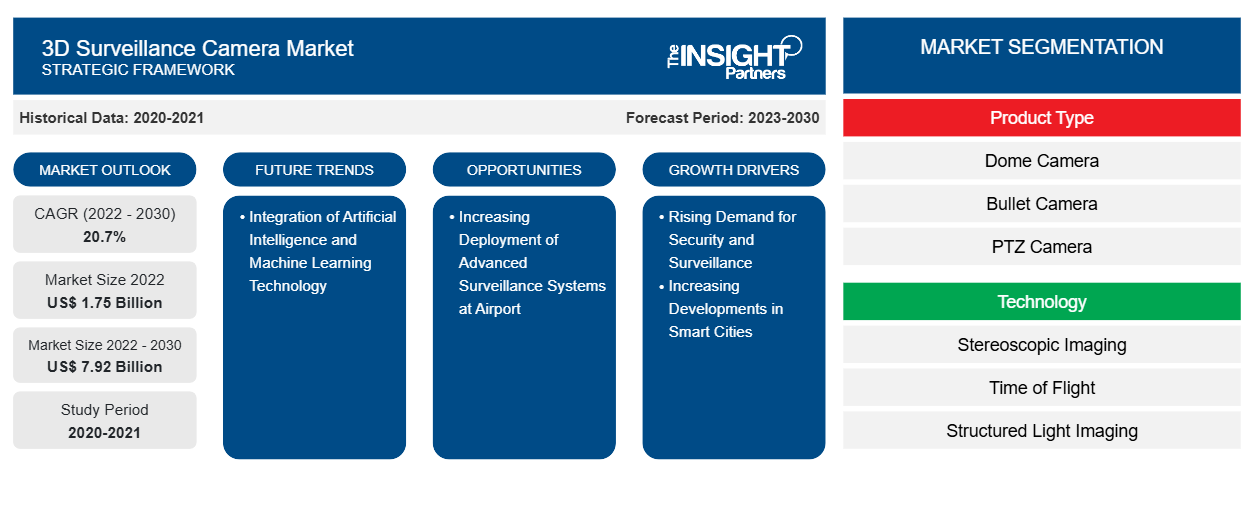3D 監視カメラ市場は、2022 年の 17 億 5,000 万米ドルから 2030 年には 79 億 2,000 万米ドルに達すると予測されています。市場は 2022 年から 2030 年にかけて 20.7% の CAGR を記録すると予想されています。予測期間中、空港での人物や物体の追跡、顔認識のための 3D 監視カメラの採用増加が、3D 監視カメラ市場の主要なトレンドになると予想されます。
3D監視カメラ市場分析
新たな石油・ガス精製所の建設と世界規模での採鉱活動の拡大は、3D監視カメラ市場の成長を牽引する主な要因です。また、倉庫や製造業における物体の識別や衝突回避に役立つ産業用ロボットの需要の高まりも、3D監視カメラ市場の成長に有利な機会を生み出しています。さらに、製造現場での作業を加速し事故を回避するために3DカメラにAIとMLを統合するなど、技術の進歩が進むことで市場が拡大すると予想されています。
3D監視カメラ市場の概要
3D カメラは、画像の奥行きを知覚して 3 次元を再現できる画像デバイスです。監視カメラは、公共エリアと私的エリアを監視するだけでなく、人物の識別にも使用されます。これにより、政府は市民のプライバシー権を守りながら公共スペースを保護することができます。これは、セキュリティと品質を高めながらプロジェクト コストを削減する、シンプルで迅速かつ効率的な方法です。3D 監視カメラは、病院、銀行、製造施設、オフィス、大学のキャンパスなど、さまざまな場所で利用されています。したがって、前述の要因は、今後数年間で 3D 監視カメラ市場に大きな影響を与える可能性があります。
要件に合わせてレポートをカスタマイズする
このレポートの一部、国レベルの分析、Excelデータパックなど、あらゆるレポートを無料でカスタマイズできます。また、スタートアップや大学向けのお得なオファーや割引もご利用いただけます。
-
このレポートの主要な市場動向を入手してください。この無料サンプルには、市場動向から見積もりや予測に至るまでのデータ分析が含まれます。
3D監視カメラ市場の推進要因と機会
鉱業活動の拡大
さまざまな金属や鉱物の需要の高まりにより、世界中で採掘活動が増加しています。さまざまな国が、この高まる需要を満たすために採掘現場の拡大への投資を増やしています。たとえば、2022年8月、メキシコ鉱業会議所(Camimex)は、2022年に55億米ドルの投資を発表しました。これは、2021年から15.2%の増加です。同様に、西オーストラリア州政府によると、2022年には西オーストラリアの鉱業と石油部門に約260億米ドルが投資されました。鉱業へのこのような投資の増加は、世界中の鉱業生産をさらに高めるでしょう。スウェーデン鉱業統計2021年報告書によると、2021年のスウェーデンの鉱石生産量は8,860万トンに達し、2015年以来22%増加しています。また、オーストラリア統計局によると、オーストラリアの鉱業生産は2023年第1四半期に5.7%増加しました。このように世界中で鉱業生産が増加すると、従業員、機器、資材の安全を確保するためのセキュリティと監視の需要が高まると予想されます。リアルタイム監視のニーズが高まることで、鉱山現場での3D監視カメラの需要が高まっています。これは、当局が鉱山現場の動きをチェックし、現場での不審な活動を検出するのに役立つためです。このように、世界中で増加する鉱業活動が、3D監視カメラ市場の成長を後押ししています。
3D監視カメラ市場レポートのセグメンテーション分析
「3D監視カメラ分析」は、製品タイプ、技術、アプリケーション、地理の各セグメントを考慮して実行されました。
- 技術に基づいて、3D監視カメラ市場は、立体画像、飛行時間、構造化光画像に分けられます。緊急停止システムセグメントは、2022年に3D監視カメラ市場で最大のシェアを占め、2022年から2030年の間に最高のCAGRを記録すると予想されています。ステレオビジョン技術は、監視およびセキュリティシステム、産業および製造環境で品質管理および検査タスクに広く利用されています。この技術を使用すると、カメラはエリアの3Dモデルまたは深度マップを作成できます。これは、ロボット工学、仮想現実、ロボット工学、自律走行車など、さまざまな目的に利用できます。
- この技術は、安全アプリケーション、医療技術、農業ロボット、ビンピッキング、物体追跡、3D 記録と製造、モバイル ロボット ナビゲーションでの距離検知にも使用されています。さらに、飛行時間技術は最も速い CAGR で成長すると予想されています。これらのカメラは、ジェスチャー認識、物体検出と認識、3D スキャンなどに使用できます。この技術は、ロボット工学、拡張現実、仮想現実アプリケーションにも使用されています。ToF は、赤外線を使用して深度情報をリアルタイムで記録することで、高速で正確な深度測定を提供します。
地域別3D監視カメラ市場シェア分析
3D 監視カメラ市場レポートの地理的範囲は、主に北米、アジア太平洋、ヨーロッパ、中東およびアフリカ、南米および中米の 5 つの地域に分かれています。
アジア太平洋地域は、化学および医薬品業界の驚異的な成長により、3D監視カメラ市場で大きなシェアを占めると予想されています。この地域の市場プレーヤーは、製造施設の拡張に継続的に取り組んでいます。たとえば、2022年12月、Balaxi Pharmaceuticalsは、インドのテランガーナ州に新しい医薬品製造施設の建設を開始したと発表しました。同社はこのプロジェクトに約1,029万米ドル(8億5,000万インドルピー)を投資しました。新しい生産施設は、同社が欧州市場に参入し、現在の市場で利益率を高めるのに役立ちます。同様に、2021年9月、Hanwha Corp.は、2024年までに硝酸生産工場を建設する計画を発表しました。この工場は、韓国の麗水工業団地に年間40万トンの生産能力を提供します。これに、同社は1億6,200万米ドル(1,900億ウォン)を投資します。したがって、この地域で新しい生産施設が増えると、工場での事故を防ぐのに役立つセキュリティソリューションの需要が高まり、3D監視カメラ市場の成長が促進されます。
3D監視カメラ市場のニュースと最近の動向
3D 監視カメラ市場は、重要な企業出版物、協会データ、データベースを含む一次調査と二次調査後の定性的および定量的データを収集することによって評価されます。以下は、市場の動向の一覧です。
- 2023年6月、大手スマートIoTソリューションおよびサービスプロバイダーであるIMOUは、IMOUが独自に開発したAIアルゴリズムマトリックスであるIMOU SENSEを搭載した初のパン&チルトスマート屋内および屋外セキュリティカメラであるRex 3DとCruiser 2を発売しました。強力なAIアルゴリズムに基づいて、Rex 3DとCruiser 2は人物とペットの認識精度が99%です。20ミリ秒でオブジェクトを認識し、データを処理し、画像内の人間とペットのターゲットをすばやく見つけ、0.6秒以内にアプリに通知を即座に送信し、ユーザーは迷惑な誤報を受け取ることなく重要なものを監視できます。(出典:IMOU、プレスリリース)
3D監視カメラ市場の地域別分析
予測期間を通じて 3D 監視カメラ市場に影響を与える地域的な傾向と要因は、Insight Partners のアナリストによって徹底的に説明されています。このセクションでは、北米、ヨーロッパ、アジア太平洋、中東およびアフリカ、南米および中米にわたる 3D 監視カメラ市場のセグメントと地理についても説明します。

- 3D監視カメラ市場の地域別データを入手
3D監視カメラ市場レポートの範囲
| レポート属性 | 詳細 |
|---|---|
| 2022年の市場規模 | 17億5千万米ドル |
| 2030年までの市場規模 | 79.2億米ドル |
| 世界のCAGR(2022年 - 2030年) | 20.7% |
| 履歴データ | 2020-2021 |
| 予測期間 | 2023-2030 |
| 対象セグメント |
製品タイプ別
|
| 対象地域と国 |
北米
|
| 市場リーダーと主要企業プロフィール |
|
市場プレーヤーの密度:ビジネスダイナミクスへの影響を理解する
3D 監視カメラ市場は、消費者の嗜好の変化、技術の進歩、製品の利点に対する認識の高まりなどの要因により、エンドユーザーの需要が高まり、急速に成長しています。需要が高まるにつれて、企業は提供を拡大し、消費者のニーズを満たすために革新し、新たなトレンドを活用し、市場の成長をさらに促進しています。
市場プレーヤー密度とは、特定の市場または業界内で活動している企業または会社の分布を指します。これは、特定の市場スペースに、その規模または総市場価値と比較して、どれだけの競合相手 (市場プレーヤー) が存在するかを示します。
3D監視カメラ市場で事業を展開している主要企業は次のとおりです。
- ヘキサゴンAB
- 3dEYE株式会社
- ハネウェル
- ロバート・ボッシュ GmbH
- パナソニックホールディングス株式会社
- LGエレクトロニクス
免責事項:上記の企業は、特定の順序でランク付けされていません。

- 3D監視カメラ市場のトップキープレーヤーの概要を入手
3D監視カメラ市場レポートの対象範囲と成果物
「3D監視カメラ市場規模と予測(2022-2030年)」レポートでは、以下の分野をカバーする市場の詳細な分析を提供しています。
- 対象範囲に含まれるすべての主要市場セグメントの世界、地域、国レベルでの市場規模と予測
- 市場の動向(推進要因、制約、主要な機会など)
- 今後の主な動向
- 詳細なPEST/ポーターの5つの力とSWOT分析
- 主要な市場動向、主要プレーヤー、規制、最近の市場動向を網羅した世界および地域の市場分析
- 市場集中、ヒートマップ分析、主要プレーヤー、最近の動向を網羅した業界の状況と競争分析
- 詳細な企業プロフィール
- 過去2年間の分析、基準年、CAGRによる予測(7年間)
- PEST分析とSWOT分析
- 市場規模価値/数量 - 世界、地域、国
- 業界と競争環境
- Excel データセット
最新レポート
関連レポート
お客様の声
購入理由
- 情報に基づいた意思決定
- 市場動向の理解
- 競合分析
- 顧客インサイト
- 市場予測
- リスク軽減
- 戦略計画
- 投資の正当性
- 新興市場の特定
- マーケティング戦略の強化
- 業務効率の向上
- 規制動向への対応























 無料サンプルを入手 - 3D監視カメラ市場
無料サンプルを入手 - 3D監視カメラ市場